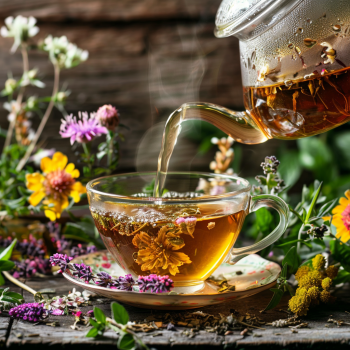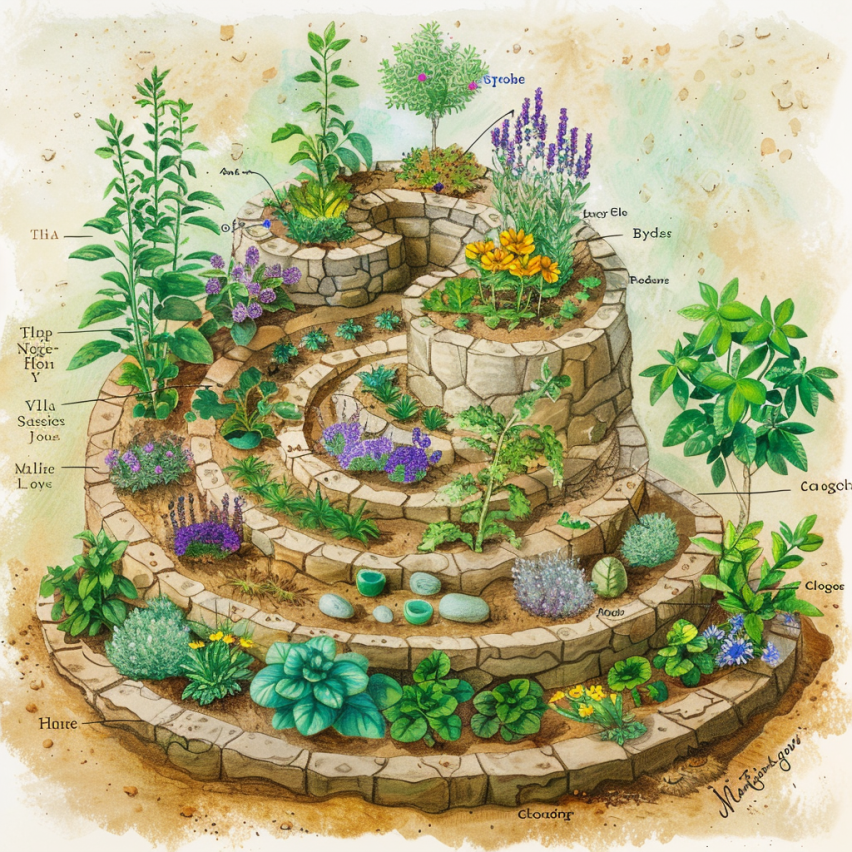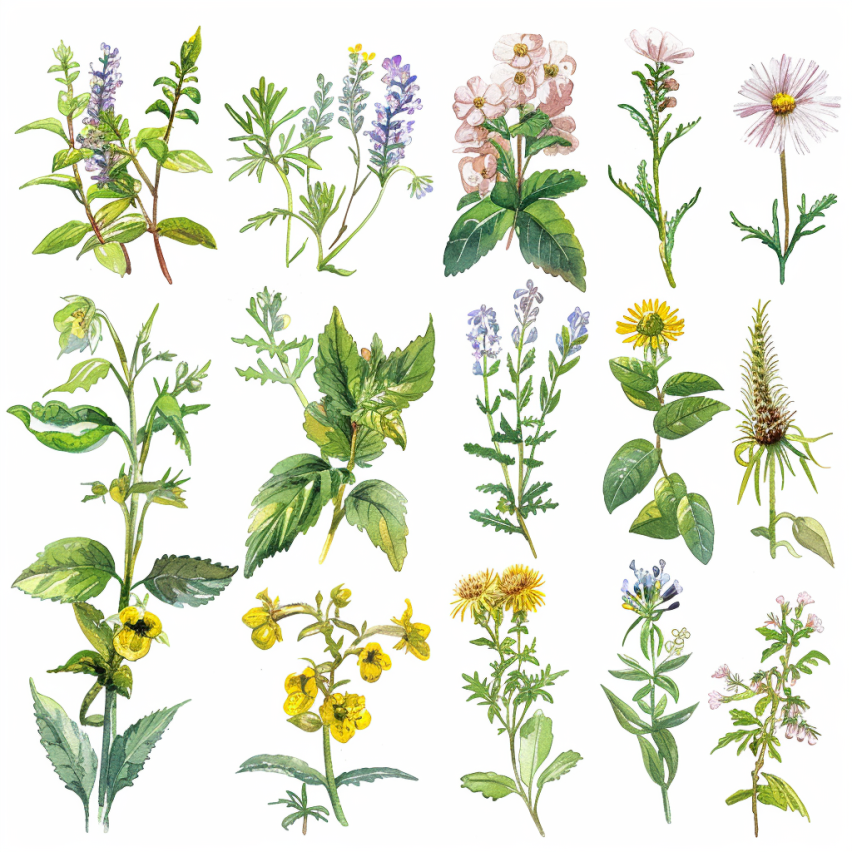
Hey, lovely green thumbs and tea enthusiasts! If you’re dreaming of transforming your little slice of the outdoors into a haven of tranquility and healing, then you’re in for a treat. This is your guide on how to grow your own herbal tea garden. But first, let’s get our hands dirty with a bit of permaculture magic—the herbal spiral.
The herbal spiral is a cornerstone of permaculture design, offering a miniature ecosystem that mimics the natural coexistence found in wild landscapes. Its clever design capitalizes on vertical space, conserving ground area while creating diverse micro-environments for a variety of plants. But it’s more than just a space-saver—it’s a living sculpture, a conversation piece, and most importantly, a sanctuary for your cherished herbs.
Imagine a spiral rising gracefully from the ground, its arms wide open, ready to embrace a medley of herbs. Constructed typically from stones, bricks, or whatever durable materials you have on hand, the spiral winds upwards, creating a mound. This isn’t just for aesthetics; the varying heights and orientations offer different exposure to sun, shade, moisture, and drainage, allowing you to plant a diverse range of herbs in a relatively compact space.
Why a Spiral? The shape itself is significant. Much like the traditions of how to celebrate Ostara, which honor the balance and renewal of life, the spiral in your garden symbolizes the harmony and interconnectedness of nature. how to celebrate ostara involves rituals that mirror the natural cycles, just as your herbal spiral reflects the perpetual motion of growth and evolution. Spirals are found throughout nature, from the galaxies above to the patterns of shells and the way water drains. They represent growth, evolution, and the perpetual motion of life. Just as natural egg dyeing brings out the vibrant hues hidden within simple ingredients, the spiral in your garden reveals the hidden potential of your herbs, creating a dynamic and colorful ecosystem. natural egg dyeing is a beautiful way to connect with nature’s palette, much like how your herbal spiral connects you with the earth’s rhythms. In your garden, the spiral symbolizes the harmony and interconnectedness of nature, providing a balanced habitat for your plants to thrive.

Top Tier (Sun-Lovers): This is high real estate for your drought-tolerant, sun-worshipping herbs. Lavender, with its calming fragrance and beautiful blooms, and oregano, a kitchen staple, are perfect candidates for the top.
Middle Tier (The Balancers): Here lies the middle ground, ideal for herbs like sage, which appreciates sunlight but doesn’t mind a bit of shade and moderate moisture. Basil, another culinary favorite, also fits well in this zone, enjoying the warmth without the scorching heat.
Bottom Tier (Moisture Seekers): The base of your spiral will be cooler and retain more moisture, making it a haven for herbs like cilantro, which tends to bolt in too much heat, and parsley, a versatile culinary herb that likes to keep its feet wet.
Let’s get real for a sec. Growing your own tea garden is like hitting the jackpot in the game of life. Not only do you get to play Mother Nature, nurturing your plants from tiny seeds to robust, leafy friends, but you also get a front-row seat to the magic show that is plant growth. It’s about forming a bond with each herb, understanding its needs, whispers, and the unique vibes it brings to your life and cup.
Companion planting is like setting up a garden playdate. Just as we can learn life’s lessons from our animal guides, observing the interactions between different plants can teach us about harmony and support in nature. life’s lessons from our animal guides offer insights into the natural world, similar to how companion planting reveals the benefits of mutual growth and protection among your herbs. It’s about pairing plants that help each other grow, repel pests, or even enhance each other’s flavors. For example, chamomile can boost the growth and flavor of mint, while yarrow attracts beneficial insects that help protect your whole herbal ensemble.

Let’s explore our ten herbal superstars, their easy-grow vibes, their soul-soothing properties, and who they love to hang out with in the garden (aka companion planting).
Companions: Sage and Lavender Mugwort is a robust plant that thrives with little fuss. Nestle it in a spot with full sun to partial shade and watch it grow with minimal effort. Revered for its ability to enhance dreams and soothe the digestive system, mugwort can be your nightly tea ritual for a peaceful slumber. Dive into its mystical properties with a deep read here.
Companions: Cilantro and Chamomile Yarrow is as sturdy as they come, flourishing in full sun and handling drought like a champ. It’s your garden’s first aid kit, brilliant for healing wounds and reducing fever. Its beauty attracts beneficial insects too, making it a garden superhero. Learn more about yarrow’s healing magic right here.
Companions: Mint and Lemon Balm In the softer light and moist soil of your garden’s understory, Skullcap will happily spread its calming vibes. A balm for anxiety and sleep issues, it’s like a cup of zen for your nervous system. Discover skullcap’s serene benefits with this guide.
Companions: Lavender and Calendula Blooming with sun-kissed cheer, Saint John’s Wort prefers its feet in well-drained soil under the full sun. It’s a beacon of light for those facing mild depression or skin troubles. Bask in its glow and learn more here.
Companions: Dill and Fennel Towering Mullein demands its place in the sun, asking little more than to bask in its rays. A guardian for your lungs, it’s the go-to for respiratory health, softening coughs and soothing irritation. Explore mullein’s full breath of benefits in this article.
…And the same deep dive applies to hibiscus, dandelion, stinging nettle, pine, and chamomile. They’re not just plants; they’re partners in your journey to wellness, offering their unique strengths and flavors to your tea cup.
Growing your own tea garden isn’t just rewarding; it’s surprisingly simple. Most herbal friends are low-maintenance, asking for just a few basics: sunlight, water, and a bit of love. Regular watering (but not overdoing it!), a sunny spot (or partial shade for some), and well-draining soil is often all it takes to see your garden flourish.
Embracing the art of growing your own tea garden is a step towards self-sufficiency, wellness, and a deeper connection with the earth. It’s an act of love—not just for yourself but for the planet. Each sip of your homegrown tea is a reminder of the beauty and resilience of nature, and of your own role in that beautiful cycle.
Ready to turn your dream garden into a reality? Don’t forget to check out our Handcrafted Remedy Tea Recipe Cards on TinyBiotics for inspiration and guidance on blending your homegrown herbs into soothing, healing teas.

There you have it, a verdant path laid out for your gardening and herbalist journey. Remember, each plant in your garden holds a story, a slice of nature’s wisdom ready to be shared. So, put on your gardening gloves, brew yourself a cup of ambition, and let’s get planting. Your tea garden awaits, ready to unfold its wonders one leaf, one flower, one cup at a time. Here’s to sipping on sunshine and growing a little magic in our lives. 🌼🍵💚